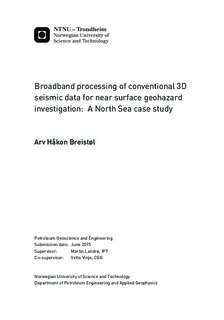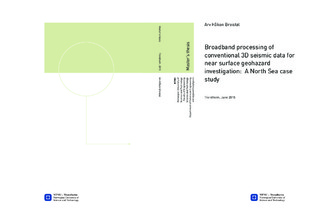| dc.description.abstract | 3D exploration seismic data is increasingly being utilized for geohazard studies in the offshore oil and gas industry. An important criterion for the success of this approach is that the seismic data contain the broadest frequency bandwith possible. This study aims to display the potential of old vintage 3D exploration data in geohazard studies using targeted broadband processing.
The processing workflow delivers a n near surface volume suitable for geohazard assessment. A Central North Sea data set, acquired in 1991 by Geco-Prakla using a dual source/dual streamer-configuration, was processed using best practice commercial processing technology to image a shallow gas hazard.
Raw shot gathers displayed decent quality, but suffered from seismic ghosts, low frequent linear noise trends and multiples. The data was source designatured using a custom signature deconvolution successfully recovering frequencies in 80-100 Hz range. A K-filter followed by a Radon filter was applied, effectively mitigating the main linear noise content. Receiver deghosting was perfomed using least squares linear Radon equations showing enhanced imaging, but limited improvement in the frequency spectrum arguably due to natural notch diversity in the acquisition stage. Demultiple was performed using Tau-p gap deconvolution, before binning and regularization was applied. Migration was applied using Kirchoff time algorithm.
The work demonstrates the use of 3D seismic exploration data in a shallow gas geohazard study. Using targeted processing we were able to define the extent and magnitude of the shallow gas hazard, effecetively illustrating its value and potential in proactive risk assessment for the offshore hydrocarbon exploration and production operation. | |

